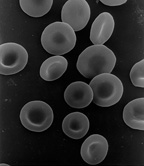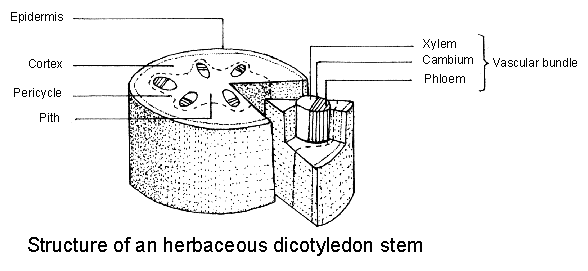Cell Specialisation and Organism Organisation
Multicellular organisms contain a wide range of different cells. Every cell is specialised to perform its function as best as possible. There are many differences between different cells specialised for different functions. Cells may have different shapes, different contents or different numbers of an organelle.
In order for a cell to become specialised, a process called Differentiation occurs, where unspecialised cells (called Stem Cells) produce cells with specialised structures.
All multicellular organisms contain some form of Stem Cells. These are the cells that divide to replace damaged or old tissue, or new cells for growth.
In plants, Stem Cells are found in Meristematic Tissue. New cells are continuously being produced since the plant continues to grow throughout its lifetime.
In humans, early embryos consist of Stem Cells that can produce any type of cell. These cells are described as Totipotent. Stem Cells are also found in a few places in adults, but these can only differentiate into a limited number of types of cell and are called Multipotent.
Organisation
Cells that work together to perform a particular function are organised into Tissues. Examples of Tissues include Xylem Tissue, Ciliated Epithelial Tissue and Parenchyma Tissue.
- In animals, Tissues are grouped into four main categories:
- Epithelial Tissue - Linings and layers
- Connective Tissue - Holding structures together
- Muscle Tissue - Actuation of movement
- Nervous Tissue - Communication via electrical signals.
Tissues that work together to perform a larger function are organised into Organs. Examples include Leaves, the Heart and Kidneys.
Organs may be further organised into Organ Systems, that carry out an overall function. For example, the Circulatory System, the Nervous System, and the Reproductive System.
Examples of Cell Specialisation and Organisation
Blood Cells
- All blood cells begin as unspecialised Stem Cells in the bone marrow, which then differentiate through various paths to become specialised cells, such as Erythrocytes and Neutrophils.
- Erythrocytes, commonly known as Red Blood Cells, carry oxygen from the lungs to respiring tissues. There are specialised in several ways for their function. They contain large amounts of Haemoglobin, that holds oxygen, and many of the organelles (including the nucleus) present in normal cells are not present in Erythrocytes, to make space for more Haemoglobin. Their shape is biconcave, which maximises surface area, and so the speed of movement of Oxygen into and out of the cell.

- Neutrophils are a type of White Blood Cell that ingests and destroys invading microorganisms. They have large amounts of Lysosomes, which contain enzymes that kill ingested cells. This makes their Cytoplasm appear Granular. They also have a Lobed Nucleus, which allows for greater flexibility.
Epithelial Tissue
Epithelial Tissue is made up of Epithelial Cells cover external and internal surfaces in an animal. Different Types of Epithelial Cells exist, for example, Squamous Epithelial Cells and Ciliated Epithelial Cells.
Squamous Epithelial Cells make up Squamous Epithelial Tissue. They are flat cells that form a single thin, smooth layer that lines tubes where diffusion occurs. They occur, for example, in Alveoli and some blood vessels. They are held in place by a Basement Membrane. This is composed of Collagen and Glycoproteins, secreted by Epithelial Cells, that binds them to Connective Tissue.
Ciliated Epithelial Cells are column shaped cells, that cover many surfaces. They have tiny projections on their exposed surface, called Cilia, which beat in a synchronised pattern to move Mucus, produced by Goblet Cells, along the surface. They can be found, for example, in the Trachea, the Uterus and the Bronchi.
Spermatozoon
Spermatozoon are motile Sperm Cells. They are the male sex cell involved in sexual reproduction. They travel toward the female’s Egg and attempt to fertilize it to produce a Totipotent Zygote.
Sperm Cells are specialised in a number of ways. They have an Undulipodium (tail) which moves by energy generated by many mitochondria and propels the cell. The head of the cell contains an Acrosome, which is a specialised Lysosome that releases enzymes so that the Sperm Cell can penetrate the Ovum Coat of the Egg. Sperm Cells are also very small and thin, which aids their movement.

Root Hair Cells
- Root Hair Cells are found in the roots of plants. Their role is to absorb water and minerals in the soil. They have a large surface area, due to their hair-like projections, which eases uptake. They also have a large amount of Mitochondria, which provide more energy for Active Transport.

Xylem and Phloem
Xylem and Phloem are the transport tissues of plants. Xylem transports water and minerals up the plant, and Phloem carry sugars up and down the plant.
Both are found in Vascular Bundles. These consist of Xylem and Phloem Tissue, separated by Meristematic Tissue (undifferentiated cells) called the Cambium. The cells in the Cambium differentiate to produce new Xylem and Phloem Cells.

Xylem Tissue consists of Xylem Vessels and Parenchyma Cells. Xylem Vessels are made of dead cells that have become elongated and reinforced and waterproofed with deposits of Lignin. The dead cells also do no have any ends, so that successive cells form a tubes with wide Lumen. Xylem transports water up the plant can helps to support it.
Phloem Tissue is made up of Sieve Tubes and Companion Cells. Sieve tubes line up and their ends form Sieve Plates through which substances can move. Companion Cells lie next to Sieve Tube Cells and allow them to stay alive.
Photosynthesis in Leaves
Leaves are the main Organs in which Photosynthesis occurs. Several Tissues and Cells are specialised to work together to maximise the rate of Photosynthesis.
The Upper Epidermis of the leaf is transparent and lets light through to the Palisade Layer beneath. The Palisade Layer consists of long, thin Palisade Mesophyll Cells. They are specialised for carrying out Photosynthesis since they contain large amounts of Chlorophyll, and their long shape maximises light absorption.
The layer of Spongy Mesophyll beneath has many air spaces to maximise gas circulation. Veins also run through the leaf which contain Xylem and Phloem Tissue. These transport the water to Photosynthesising cells and transport the products of Photosynthesis to other parts of the plant.
The Lower Epidermis of the leaf contains Pores known as Stomata, which allow the movement of gases in and out of the leaf. A Stoma is made from two Guard Cells. These have spiral thickenings of Cellulose which mean that when the Cells are Turgid, the Stoma opens, and when they are Flaccid, the Stoma closes.
